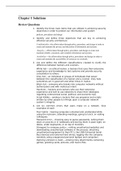Lecture notes
B3.1.3: Transport in plants - OCR A Biology A level A* student notes
These notes use information from two textbooks, the internet and extra information from my lessons, and cover each specification point for this topic. They are fully comprehensive and include diagrams etc. Helped me achieve an A* in Biology A level.
[Show more]













